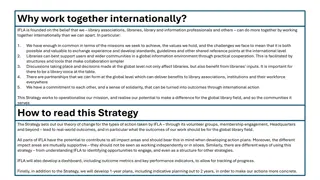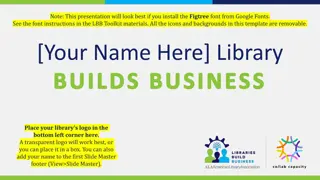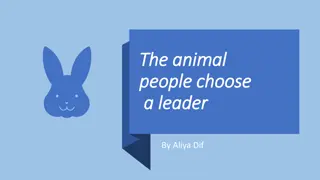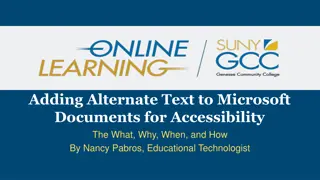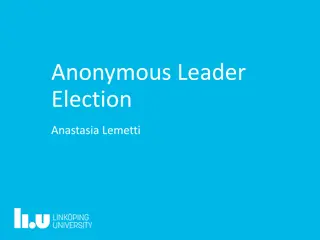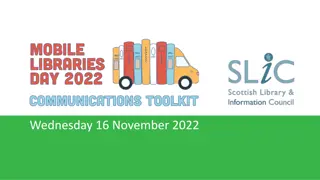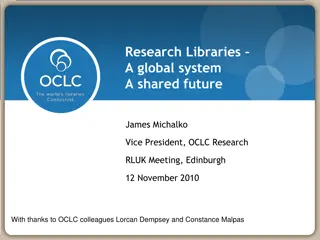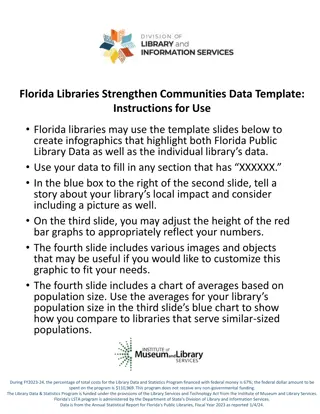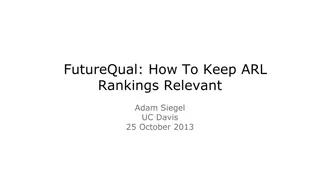Arturo Schomburg: A Leader in Libraries Text Talk
In this presentation, learn about the significance of libraries and librarians in communities, the role of Arturo Schomburg in promoting diversity in library collections, and the inspiring stories of individuals like Marley Dias who worked towards inclusivity and representation in literature.
Download Presentation

Please find below an Image/Link to download the presentation.
The content on the website is provided AS IS for your information and personal use only. It may not be sold, licensed, or shared on other websites without obtaining consent from the author.If you encounter any issues during the download, it is possible that the publisher has removed the file from their server.
You are allowed to download the files provided on this website for personal or commercial use, subject to the condition that they are used lawfully. All files are the property of their respective owners.
The content on the website is provided AS IS for your information and personal use only. It may not be sold, licensed, or shared on other websites without obtaining consent from the author.
E N D
Presentation Transcript
Arturo Schomburg: A Leader in Libraries Text Talk Week 6, Day 1
Slide 1 A library is a room or building with collections of books, magazines, music, and other resources for people to read and borrow. Librarians keep the library organized and help people find what they need when they visit.
Slide 2 A public library is a library that is free and open to all members of the community. The first public library in the United States was the Boston Public Library. The library in Copley Square opened in 1895. It was the first library in the United States to include a children s room.
Slide 3 Librarians are responsible for helping to decide what kinds of books are in a library. They think about what people like to read and what is important for people to know and be able to learn about.
Slide 4 Marley Dias is not a librarian, but she loves libraries. But she discovered that libraries sometimes do not have the books to tell all people s stories. She started #1000BlackGirlBooks to change that.
Slide 5 A long time before Marley, someone else discovered the same problem and did something to change it. Arturo Schomburg was born in Puerto Rico in 1874. When Arturo was a child, he wondered why he was not learning in school about people who looked like him, about people like his own family who came from African countries.
Slide 6 Arturo started to study history on his own to find out about great people who made important contributions to their communities. He searched and searched to learn about Black inventors, writers, thinkers, and leaders. Arturo was inspired by Benjamin Banneker, who invented the wooden clock. He was a farmer, a mathematician, an astronomer and an author.
Slide 7 When he was 17 years old, Arturo moved from his home in Puerto Rico to New York City. There, he lived around other Puerto Rican and Cuban people. It was important to Arturo to help make his community stronger. He collected as many books and other resources by African people as he could. He said he had the book hunting disease.
Slide 8 His family described their home like this: There were books from the cellar to the top floor, in every room, including the bathroom. Arturo collected over ten thousand documents about the people and history of Africa and the places African people live. He had so many documents that he could no longer keep them in his house. He donated his collection to the New York Public Library and became its librarian.
Slide 9 Today, the Schomburg Center for Research in Black Culture of the New York Public Library is an important research center, with more than 10 million items.
Citations Slide 1: library http://lbplchildren.blogspot.com/ Slide 2: BPL https://en.wikipedia.org/wiki/Boston_Public_Library; children s room https://www.bpl.org/services-central- library/childrens-library-at-the-central-library/ Slide 3: librarian portraits https://www.finebooksmagazine.com/fine_books_blog/bright-young-librarians/ Slide 4: Marley https://kristof.blogs.nytimes.com/2016/09/06/1000blackgirlbooks-campaign-expands/ Credit Christopher Occhicone for The New York Times Slide 5: shomburg portrait https://www.blackpast.org/african-american-history/schomburg-arturo-alfonso-1874-1938/ Slide 6: bnejamin banneker stamp https://www.mysticstamp.com/Products/United-States/1804/USA/ Slide 7: harlem https://www.npr.org/templates/story/story.php?storyId=129827444 Slide 8: piles of books https://www.the-tls.co.uk/get-rid-book/ Quote: https://brooklyneagle.com/articles/2012/01/24/on-this-day-in-history-january-24-a-pioneer-of-black-history/ Slide 9: schomburg center https://www.nypl.org/locations/schomburg






